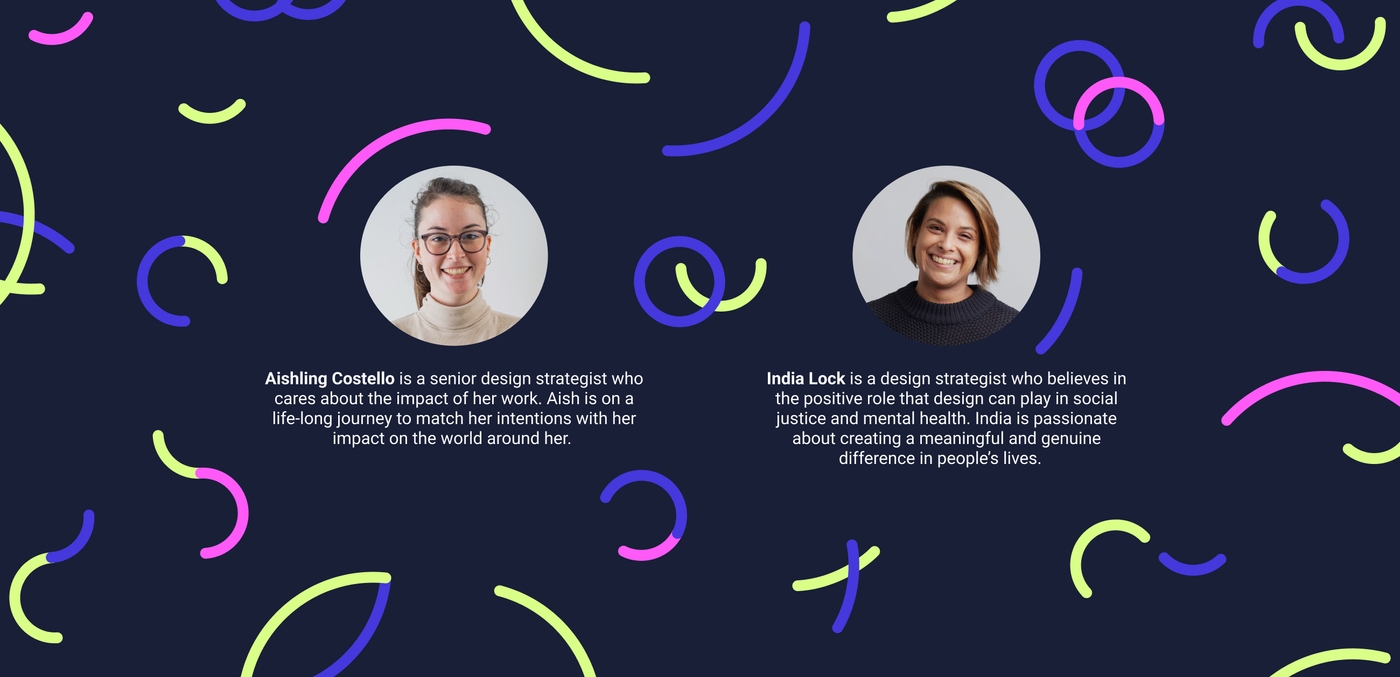So what is trauma responsive design, anyway?
As human-centred designers we’ve been asking ourselves, what does trauma mean for our work? And to take it a step further, how might we make design more trauma responsive?
Why are we asking these questions? (Good question!) We believe that trauma responsive design is key to creating products, services and systems that respond to the unique needs of people with lived experience of trauma. We believe that trauma responsive design needs to be more widely understood and adopted as a practice, so that services and experiences can be designed with and for people who have experienced trauma.
Through a Portable R&D project, we’ve been exploring how to build a trauma responsive design practice. In this article, we’ll start breaking this down and exploring what it means for design.
Trauma and the experiences that can cause trauma are all around us. Everything from natural disasters to car accidents to adverse life experiences have the potential to lead to trauma. It is estimated that 3 out of 4 Australians (75%) have experienced at least one traumatic event in their lifetime (Australian Institute of Health and Welfare, 2020). If more than half of the Australian population have experienced at least one traumatic event, then it stands to reason that a large number of people with lived experience of trauma are coming into contact with the products, services and systems that designers are designing.

But what do we really mean by trauma?
By its very nature trauma is difficult to define. The experience of trauma is so subjective and individual that it almost defies definition. But, I hear you ask, trauma is universal isn’t it? Well, yes, it is. And it isn’t. In the lecture series Anthropology of Trauma, Dr Alex Pavlotski shared that trauma is universal, it crosses cultural and geographical boundaries. And, while all humans have the neurobiological capacity to experience trauma, it's an individual experience. Two people could experience exactly the same event and yet one might be traumatised and the other might not. While we have an understanding of the common symptoms experienced, people tend to experience a different constellation of those symptoms.
No wonder trauma is difficult to define.
In academic circles, it’s recognised that the subjective nature of trauma makes it very difficult to arrive at a single shared definition (Mersky, Topitzes & Britz, 2019). In medicine, trauma is no less complicated to define. To further confuse things, historically, shared stories of trauma have been actively discredited and stigmatised from a medical perspective.
We’re also seeing the rise of trauma being spoken about in mainstream culture. It’s in our newsfeeds and is the latest trend on TikTok, spawning a whole subset of social media content dubbed ‘trauma-toks’. And while we see an increase in people talking about trauma, it still remains an oft-stigmatised topic and experience.
The word trauma is everywhere. It can feel uncomfortable to talk about, which suggests that raising awareness and challenging stigma can only be a good thing. After all, as Peter Levine says in his book Healing Trauma, ‘trauma is the most avoided, ignored, denied, misunderstood and untreated cause of human suffering.’
But the rise of trauma in the public sphere also comes with a downside. As with any complex topic that is rapidly shifting into common language, the word ‘trauma’ is becoming increasingly used and misused in popular parlance.
Definitions matter.
As designers, a definition helps us create a shared language and guide our focus. Armed with a definition, human-centred design can more effectively respond to and design experiences that affect large groups of people.
In the context of design, Rachael Dietkus has drawn together the following definition, referencing research and work from Bessel van der Kolk, Resmaa Menakem and Karine Bell:
'In a design context, ‘trauma is a response to anything that is overwhelming and that happens too much, too fast, too soon, or for too long.
It is coupled with a lack of protection or support. It lives in the body, stored as sensation: pain or tension - or is a lack of sensation, like numbness.
It does not impact us all in the same way. Context is critically important.’
This definition supports human-centred designers to respectfully learn from and collaborate with people who have lived experience of trauma. It enables designers to learn about trauma and its impacts on people. This definition supports designers to consider how our design of products, services and systems could be shaped to reduce harm and mitigate the risk of re-traumatisation.
Research has shown that trauma affects our brains, our bodies and our beliefs. It impacts all aspects of a person’s life, right down to how they interact with a product, service or system.
Consider for a moment a person who has experienced a traumatic event related to large crowds of people. This event has led to the person becoming scared of being in crowded or highly populated areas. When they do, they experience panic attacks and anxiety. Now consider what this means in terms of the person’s ability to work. Pre-pandemic, most of us worked in highly populated areas, such as major metropolitan areas or districts. Now, this person might be able to receive special dispensation to work from home, but in order to do so they might have to pass a series of medical examinations. Now imagine that the company organising those examinations was using a service process that wasn’t trauma informed. They might require the person to attend a medical examination in the city, an area that (pre-pandemic) is typically highly populated. What a dilemma for this person!
Now this is just a hypothetical example that we have used to illustrate our point, but it does help to highlight the role that design can play. When working on service redesign, for example, designers consider ways in which a redesign meets the needs of all people interacting with that service in the future. This creates the opportunity to redefine experiences that traumatised people have when they interact with products, services and systems, so that they are not re-traumatised.

Which brings us neatly into trauma responsive design.
Trauma responsive design is an approach to design that is informed by an understanding of trauma and how it impacts people. What makes this design practice responsive, is that the designers practising it not only have knowledge about trauma, but they actively use this knowledge to inform their approach to design. It’s a simple-sounding concept on paper, but is a deep, considered practice.
Trauma responsive design is a mindset. It is an understanding that trauma can influence every aspect of someone’s experience of the world. At all times, a trauma responsive designer is seeking to empower and respect the innate strengths and capacities of individuals with lived experience of trauma. And at no times does a trauma responsive designer reduce individuals or communities to a single identity: traumatised. Trauma responsive design seeks to reduce the potential for harm and minimise the risk of re-traumatisation. It focuses on respectfully learning from and collaborating with people who have lived experience in order to inform the design of products, services and systems.
For example:
A trauma responsive designer will proactively create design research activities that consider the key impacts of trauma on a person. One example of this would be ensuring that someone with lived experience of trauma who is participating in design research has a clear understanding of the choices they can make regarding their own participation. So, the person will know that they can choose to leave at any time. They will know that they can choose to take a break or can choose not to answer something that feels uncomfortable for them. In this scenario, the designer has created the conditions that enable the participant to exercise meaningful choice and effectively manage their own participation in line with their own individual needs.
What’s key here is ensuring that the choices available to someone are meaningful. It’s not simply an opt out. Let’s look at grounding exercises as an example. We’ve probably all come across some form of structured breathing or mindfulness activity that is intended to help people centre themselves and manage difficult emotions. Which is great. Except that for many people who have experienced trauma being asked to focus on their breathing and their bodies is incredibly unsafe.
During a lecture series about trauma and trauma responsive design, we experimented with a different approach to grounding. If you offer a single breathing exercise that is opt out, it’s easy for people to maintain their safety by choosing not to participate. But they have also missed out on the benefit of the exercise, which seems unfair. So we experimented with offering several exercises that focus on different grounding techniques, such as a physical exercise (a quick dance) or a cognitive exercise (remembering 7 things). As well as these, we offered a third option where people could complete their preferred grounding exercise on their own (make a cup of coffee, water your plants, read a book) for an agreed period of time. This approach provides meaningful choice for people to self-select a grounding activity, that meets their needs and supports everyone to achieve the same outcome. No matter what choice they make.
So what would be different if the service was 'trauma responsive'?
Now let’s take it a step further. Let’s re-consider our previous example of the medical examination. If you remember, our person needed to attend a medical examination to receive special dispensation to work from home as they experience panic attacks and anxiety in crowded places. But in order to get the dispensation they had to travel to a crowded place to complete the examination.
Well, it would include opportunities for the person to request support. It would have meaningful choices built in throughout the process. It would ensure the person had a clear understanding of the process steps and what to expect. For example, when initially booking the examination appointment, the person could be asked if they had any concerns or preferences regarding attendance. This could then be followed up with a choice of medical examination locations.
This is just one small example of how trauma responsive design can learn from and empower the innate strengths and capacities of people with lived experience of trauma. Not only does this approach benefit people with lived experience of trauma, but it is of benefit to everyone. We can all appreciate a service that features clear information and offers us meaningful choices along the way.
As we learn more through our research we will continue to share articles and engage in conversations with people who have lived experience as well as designers in the community at large. We’ll share more insights about what trauma responsive design is and how to cultivate it in your own practice.
Interested in our work?
If you would like to learn more about our research or would like to contribute on this project, we encourage you to follow the link below to reach out to our team.
